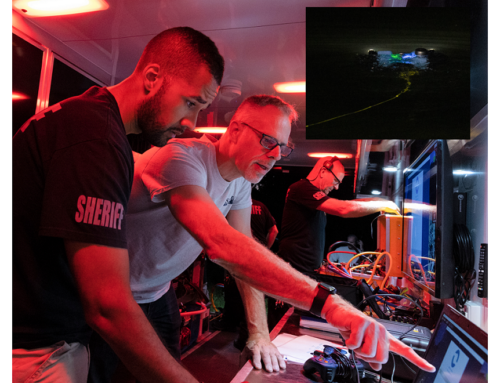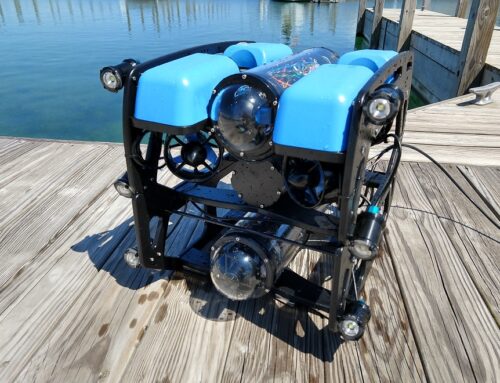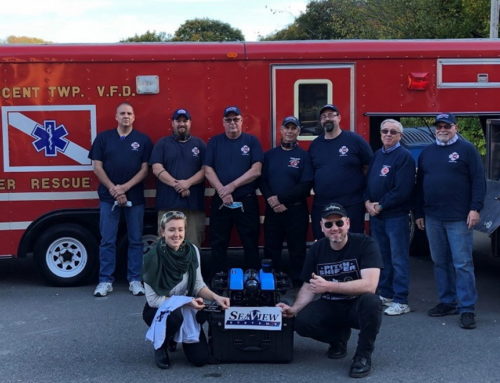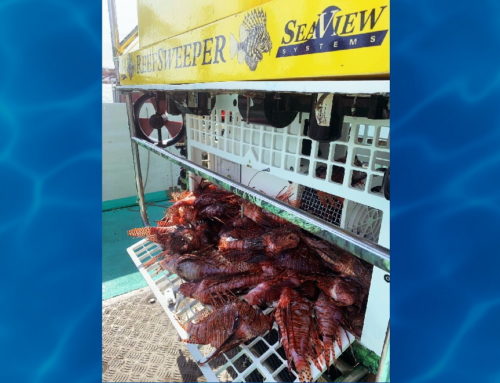Nearly 100 years after the three-masted schooner Hattie Wells sank in Lake Michigan, USA, during heavy weather, it has been filmed by SeaView System’s Falcon ROV. A key element of the mission undertaken by a team of marine archaeologists has been to prove the value of using an ROV to document shipwrecks in America’s Great Lakes, says Dr Mark Gleason, chief marine scientist and director of education at Great Lakes Naval Memorial and Museum.
By turning to specialist ROV operator, Seaview Systems, they were able to cut the cost usually associated with launching an ROV from a large support vessel by using the compact but highly sophisticated deep-rated Saab Seaeye Falcon DR ROV.
Matthew Cook of Seaview Systems explains that marine archaeology requires the collection of high quality video, still images and environmental and position data of a shipwreck in order to capture the full historical significance of the site.
He sees an ROV as representing a very efficient means of collecting this information in a wide range of water depths.
‘One of the larger expenses in a research project,’ says Matthew Cook, ‘is the support vessel from which ROV operations are conducted. Since 2006 we have been leveraging the benefits of the compact fiber optic Falcon DR which can dive to 1000m from relatively inexpensive vessels of opportunity, in order to explore a range of historic shipwrecks, corals and other benthic habitats.
‘The fiber optic Seaeye Falcon DR represents an ideal balance of capability and ease of mobilization in a small, powerful and stable package. By deploying from a relatively inexpensive vessel of opportunity, project budget is conserved allowing for a longer, more detailed campaign. Running a wide bandwidth fiber optic system means the vehicle is able to support a host of sensors and cameras normally only found on larger vehicles.’
The Hattie Wells project that has included archival research, sidescan survey and ROV dive operations, has brought together representatives from government, private business and educational non-profits. In addition to the GLNMM, these included the Michigan Shipwreck Research Associates (MSRA), National Marine and Underwater Agency (NUMA) sponsored by author Clive Cussler, National Oceanic and Atmospheric Authority (NOAA), and SeaView Systems, Inc.
Built in 1867 the Hattie Wells was originally a 135 ft three-masted schooner, later lengthened by 30 ft and the rigging removed.
Over the years she courted disaster on a number of occasions including collision, grounding and a lightning strike. After grounding in 1892 she was given up for lost but was later salvaged as a wreck and towed back to Detroit for refit. Once again afloat, she continued in service, later as a barge.
In November 1912, whilst hauling timber, she hit heavy weather and took in water. Shifting cargo smashed the pilot house containing the donkey engine which powered the bilge pumps. With the only means of removing water gone, the vessel was doomed to sink and so the towing tug cut the hawser and rescued all five hands on board.
The Falcon DR has a world-wide following with over 220 in use offshore, inshore and down tunnels.
Users are attracted by the Falcon’s reputation for power, reliability and unequalled stability in strong cross-currents − particularly in a vehicle small enough to be manhandled into the water.
Rapid role-change during operations is a key feature where intelligent electronics offer a ‘plug and go’ simplicity that allows up to 128 devices to be added and changed easily, such as extra cameras, lights, tracking system, manipulator and sonar, plus the option of adding special tooling on a removable skid.
Its unrivalled finger-tip manoeuvrability comes from five brushless DC thrusters with velocity feedback for precise and rapid control in all directions and an ability to hold steady in strong cross currents.
The deep rated Falcon has built-in fibre optics for high volume data transmission over its long umbilical, and the ability to use broadcast quality video cameras. It also has tilting variable intensity lights linked to its camera tilt mechanism for superior illumination when filming above or below the vehicle.
Saab Seaeye is the largest and most trusted manufacturer of electrically operated ROVs in the world. Its parent, Saab Underwater Systems is itself a world leader in sensor systems, precision engagement systems, and remotely operated and autonomous underwater vehicles.
Dr Gleason of GLNMM concludes, ‘I think it is safe to say each organisation had different objectives. Ours was to demonstrate, through a real project, the usefulness of this type of ROV in documenting shipwrecks in the Great Lakes. Plus we wanted to work in partnership with Seaview, NOAA and MSRA/NUMA to explore a new shipwreck and hopefully be able to partner on larger projects in the future.’





